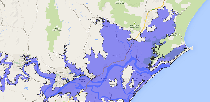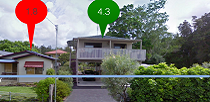- Home
- Affordability Projects
Affordability Projects
Catastrophes have damaged or destroyed property worth tens of billions of dollars in recent years. These disasters have highlighted the importance of protecting communities that regularly face risks as well as the need to provide access to affordable insurance. They have also demonstrated the need for Australia’s built environment to be less brittle in the face of natural disasters such as storms, cyclones, bushfires and floods.
The Insurance Council of Australia (ICA) is working closely with all levels of government and consumers to help communities understand risks and work towards practical solutions. Close collaboration between industry and government is critical to identifying appropriate disaster solutions, and the community needs clear signposts about steps they can take to manage their own exposure to risk from natural disasters.
The ICA has initiated several programs to tackle the impacts of extreme weather and the availability of hazard data to help understand risk and develop a more sustainable response to managing catastrophes.

National Flood Information Database (NFID)

ICA Data Globe

JCU Engineering Inspections: North QLD strata-title properties

Property Resilience and Exposure Program (PREP)
National Flood Information Database (NFID)
As part of a broader project to increase availability of flood insurance cover to the Australian community, in 2008 the general insurance industry undertook to develop an address-level flood exposure database using existing government flood mapping.
The result, the National Flood Information Database (NFID), is funded and managed by the insurance industry. It combines all available government flood mapping into a format that is practical for underwriting of flooding risks at address level, rather than at postcode or lower resolutions. It is licensed by the ICA and available to relevant stakeholders. Importantly, the insurance industry does not undertake flood mapping itself or contribute to government flood mapping programs. The industry relies upon local governments to independently produce flood mapping as part of their legislated responsibilities to the community.
Where a local or state government has provided flood mapping of an appropriate standard, NFID provides participating insurers with estimations for the depth of flooding (if any) at each individual address for the one-in-20 year, one-in-50 year, one-in-100 year :20yr and Probable Maximum Flood (PMF) events. This allows an underwriter to consider what premium may be applicable, given the nature of the building at that location.
Where data has not been made available by government, insurers are unable to offer premiums that reflect the precise nature of flooding for the location. Prudential regulation requires that insurers carefully manage their risk exposure and pricing with regard to extreme events. Where no mapping has been made available this often means a very conservative approach to setting prices.
Flood insurance availability in policies has, as a result of data becoming available, grown from 3 per cent of household policies in 2006 to 93 per cent of policies sold today.
Local governments and agencies that wish to help improve insurance pricing in their area can provide access to flood mapping by contacting ksullivan@insurancecouncil.com.au.
ICA Data Globe
The ICA Data Globe project coordinates insurance company access to an extensive database of natural hazard information, including flood, earthquake, bushfire, storm surge and cyclone exposures at an individual property level.
Data collected by the ICA is available to participating stakeholders in common GIS formats and can be visualised in a web browser at resolutions that allow identification of individual addresses.
Though providing hazard data to insurers is an important step to assist with accurate risk calculation, the tool also helps to identify where hazard mapping is missing, or where mitigation efforts to reduce existing hazards may deliver an insurance affordability outcome for local residents.




JCU Engineering Inspections: North QLD strata-title properties
Properties in Tropical Queensland are exposed to a much higher cyclone risk than other areas of Australia. The past 100 years of cyclone data shows many strata properties in Queensland face a one-in-three chance of a cyclone passing within 50km in any given year.
Modern building codes reduce the risk of buildings being destroyed or collapsing. However, cyclones cause extensive damage to buildings that can be expensive to rectify. Though the building code requires buildings to be constructed to a standard that protects life during a cyclone, it does not limit damage to the property itself.
Where the risk is higher, this is typically reflected in higher strata insurance premiums. However, the Insurance Council of Australia (ICA) and the general insurance industry are committed to working with governments and communities to reduce these risks where possible.
In February 2014, James Cook University (JCU) was engaged by the ICA to design an engineering inspection scheme for strata-title properties in North Queensland.
This follows on from an initial independent study conducted by JCU released in October 2013. It recommended strata-title properties in North Queensland undergo regular engineering inspections to ensure they are resistant to future extreme weather events, and to improve understanding of how the buildings might perform during these events.
The engineering inspection scheme for strata-title body corporates is intended to:
- Investigate and report on any specific building issues that could lead to extreme weather damage
- Identify high-level remediation options to address any detected vulnerabilities of the building to extreme weather events, for consideration by the body corporate
- Deliver a report to the body corporate on the status of the building with regard to detected extreme weather vulnerabilities
Once it’s been developed, governments can then consider adopting the scheme to assist strata owners and managers identify and potentially manage vulnerabilities to their buildings in regions exposed to extreme weather, such as cyclones.
- JCU has already undertaken a three-month study examining strata building risks from cyclonic weather by reviewing policy claims data from a number of insurers. The focus of the study was on policies active in 2010 and 2011, and claims data from those associated with 2011’s Cyclone Yasi.
JCU will provide recommendations on enabling:
- Engineering-based inspections every seven to 10 years. The aim of these inspections would be to identify and prioritise any site-specific factors that might affect building performance in future severe storm events
- Providing insurance expertise and advice to any government project aimed at developing an inspection regime that focuses on assisting strata owners in Far North Queensland
- A new study on water ingress from wind-driven rain
The strata inspection scheme being designed will, if adopted by governments:
- Provide evidence of inspections and actions taken to mitigate risk, with the potential for a reduction in insurance premiums and excess due to lower risk.
- Identify potential vulnerabilities with a focus on issues that could be addressed to improve the building’s resilience
- Develop a property rating that focuses on structural and non-structural elements such as losses associated with water ingress and damaged caused by ancillary items or features such as satellite dishes
- Develop an awareness program to highlight maintenance issues
- Seek a greater understanding of the relationship between intensity of rain and wind gusts, and identify possible economic solutions in reducing the amount of water ingress and resultant damage
Property Resilience and Exposure Program (PREP)
The natural disasters that Australia has experienced since 2010 have caused billions of dollars of damage and inflicted heartbreak and distress on the residents and businesses in dozens of towns and cities.
These catastrophes have highlighted the importance of having communities and properties that are durable and resilient to extreme weather. Constructing permanent physical mitigation infrastructure to protect at-risk towns and cities, where it is feasible, and policies to help improve community resilience, are essential if communities that are regularly affected by extreme weather are to survive and prosper.
The insurance industry seeks to demonstrate the relationship between hazard exposure, building vulnerability and risk premiums, while also providing assistance to government mitigation programs through identifying possible affordability gains as a result of various mitigation options being considered. The insurance industry is also focused on understanding and acknowledging work already done to lower risks, for example where local government development controls are performing well or mitigation has been constructed.
The Insurance Council of Australia's Property Resilience Exposure Program (PREP) provides local government and the insurance industry with more robust information on the resilience of housing stock. It enables councils and shires to engage with the insurance industry on the issue of insurance affordability, where the primary drivers may be poor-quality hazard data, or a lack of information on development controls and existing buildings. PREP seeks to improve the alignment between the data and hazard mapping relied upon by insurers to price risk, and the information local governments harness for development control and town planning purposes.
PREP has four modules:
- Module 1 – Existing hazard mapping provided by a participating local government that meets a minimum standard
- Module 2 – Building survey data for all addresses, provided by a participating local government, that insurers can use to recognise the resilience many properties already have by virtue of existing development controls
- Module 3 – A resilience heat map provided by the PREP process for participating local governments. PREP will identify areas where properties are at greater risk than others (through poor design and building controls), and identify those that may require high-priority mitigation and intervention to reduce the potential impact of the hazard on that community.
- Module 4 – Best-available hazard data and building information for underwriters. This improves their capacity to price risk at an individual address level, and to acknowledge the full benefit that local development controls and mitigation may have delivered in reducing property owners' vulnerability to extreme weather
Local governments that perceive constituents in their jurisdiction are facing an insurance affordability issue are invited to contact ksullivan@insurancecouncil.com.au.









